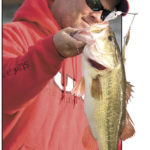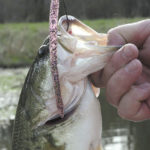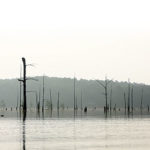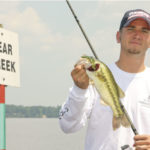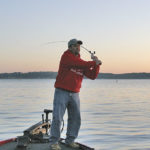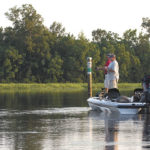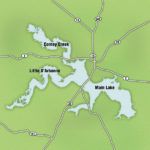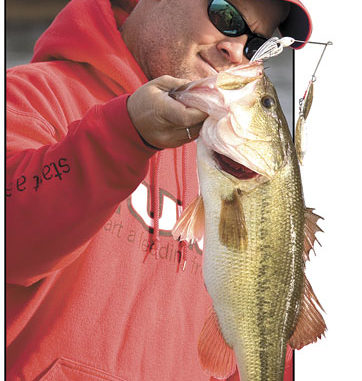
This month on Lake D’Arbonne, it pays to have a weak work ethic.
Although the summer days are loosely labeled as lazy here in Louisiana, November is actually the best month to be a lazy bass angler at Lake D’Arbonne.
At face value, late fall may sound like a time you might have to work at catching bass as they begin to move into their lethargic winter patterns, but that’s not the case at D’Arbonne. The simple fact is that if you can cast a Carolina rig and drag it across the bottom, you can catch bass at D’Arbonne this month.
The trick, though, is to drag it over a particular kind of bottom rather than dragging it willy-nilly all over the place. And this is where D’Arbonne’s miles and miles of channel come into play.
Bass can be caught just about anywhere from the bushes to the channel during November, but there are usually a couple forces in action that more or less force bass to move from their shallow haunts back to deep-water structure like flats and channel drops.
“Fishing the channel during late fall is a no-brainer for a couple of reasons,” said West Monroe tournament bass angler Kenny Covington. “First off, giant balls of shad roam up and down that channel this time of year, and, whether it’s got anything to do with cold water pushing them deep or not, bass are going to be right there with them.
“Secondly, D’Arbonne has been pulled down a few feet the last couple of years, and bass don’t have much of a choice but to move back to the channel if there isn’t any water on the shallow flats. The deep flats are good if it only comes down a couple feet. But if they draw it down 4 to 6 feet like last year, those bass don’t have a choice — they’ve got to go to the channel.”
However, telling somebody to go catch some bass on a Carolina rig fished on the edge of the channel at D’Arbonne is akin to telling somebody to find a 2/0 treble hook in a haystack. There are miles of channel that run through D’Arbonne, and, considering there are two sides to every channel, figuring out where to fish becomes problematic.
It might sound a little embellished, but the great thing about Carolina-rigging the D’Arbonne channel during November is that it really doesn’t matter. Sure, there are some spots that may stack up bass like cordwood, but bass could be just about anywhere along the channel as long as there are some shad around.
“That’s the key,” Covington said. “It’s all about the shad this time of year. Baitfish is the difference in whether you’re going to catch them on the channel no matter what part of the channel you fish. Everybody talks about the bends and the points, but the straight stretches are just as good as those spots if the bait is there.”
Although Covington feels like the Corney Creek and Little D’Arbonne arms above the Highway 33 bridge are more consistent because of increased water flow, Simsboro resident and D’Arbonne regular Sid Havard likes to stick with what’s called the main lake below the same bridge.
“I’m not too good fishing a Carolina rig,” Havard lamented, “but I whack-stacked them the first time I tried it right there on the channel below the 33 bridge. Everybody goes out there and cranks the channel during the summer, but the only time I’ve really killed them on the channel was during the late fall and early winter.”
Whether you decide to fish up the arms or down in the main lake, Covington and Havard know there’s no substitute for a Carolina rig this time of year. Throwing something different in a vain attempt to be different will be the worst decision you could make on D’Arbonne this winter.
“Carolina rigs rule,” Covington insisted. “Everybody throws them, and they’ve all got their theories as to why they work — covering water, power and finesse, whatever — and mine is that they’re so productive because they’re just about idiot-proof. It’s almost impossible to fish one the wrong way — throw it out and drag it.”
Covington’s typical Carolina rig set-up includes a 1-ounce weight, a bead and swivel, a 3-foot leader and a centipede or french fry style soft-plastic bait. Although cotton candy is generally believed to be the best color for winter, Covington says anglers make more out of color than they should.
“Talk to 10 different people, and you’ll hear 10 different colors that they all feel are the only ones to throw,” he said. “People will say if it’s not watermelon, don’t throw it. If it’s not cotton candy, don’t throw it. Everybody thinks they’ve got the magic color, and they hide it like it’s the biggest secret in the world.”
Havard agreed with Covington’s color assessment, but he admitted he has a hard time putting down cotton candy to pick up anything else. In fact, he believes sticking with one color while trying to figure out the style of plastic the bass want will lead to more bites in the long run.
“I’ve always heard cotton candy is the color for winter,” he said, “and that’s the one everybody talks about at D’Arbonne. I throw a cotton candy french fry and a cotton candy lizard until I figure out which one the fish want. Then I stick with it.”
Although it took him a long time to warm up to a 1-ounce weight, Havard says his son Chance Havard’s success with the heavy weight while fishing tournaments in Texas has taught him the importance of the heavy lead. Once he started using it at D’Arbonne, he immediately started getting more bites.
The advantage of a 1-ounce weight when fishing a Carolina rig at D’Arbonne is that it helps anglers figure out the bottom composition better than a light weight.
“You can feel everything that’s going on with a 1-ounce weight,” Havard said. “You know your bait’s on bottom, and you can control your Carolina rig a lot better. But the big thing is you can tell if it’s a mud bottom or a hard bottom.”
That might not sound like information you would want to process while trying to catch a couple bass, but to Havard and Covington, knowing what’s on the bottom is as important as anything else they take into consideration. If all their bites are coming on hard bottoms, they know to pull up immediately if they feel a muddy bottom and go search for a stretch that’s hard.
While it’s true that the Carolina rig rules D’Arbonne this time of year, both anglers made sure to pass along the fact that neither was stupid enough to try to force feed it to the fish. There may be times when other presentations are warranted, and knowing when those times are and what to throw can put you right back on the bite.
“Another good bait for me on the channel this time of year is a 3/8-ounce Mr. Hooty spinnerbait,” Covington said. “I like to cast it up on the flat and work it back to the drop-off by just barely crawling it along the bottom or by letting it fall and bouncing it up and down like a worm.”
And although he admitted he doesn’t throw it a lot, Covington says that some of his buddies are starting to have some success by “mopping up” an area with shaky heads or drop shots after the Carolina rig bite shuts down.
In bass fishing circles, “mopping up” simply means to clean up an area before leaving by offering something a little different to bass that have grown weary of seeing the same bait coming by over and over again.
“If they’ve got those gates open, and the water is low enough to see the stumps, I can tell you what else I’m going to throw,” Havard interjected. “I’m going to throw a 1/2-ounce black/brown/amber Stanley jig with a pumpkinseed trailer. You can go down those stumps either pitching or casting and get some good bites in the initial fall.”
Don’t get confused by all the other ways you “could” catch bass at D’Arbonne this month, though, because the fact is if you can throw a Carolina rig on the edge of the channel and drag it back, you can catch bass with the best of them. This lazy way of fishing will produce a lot of lively action.
